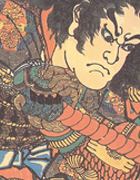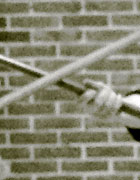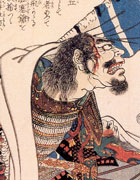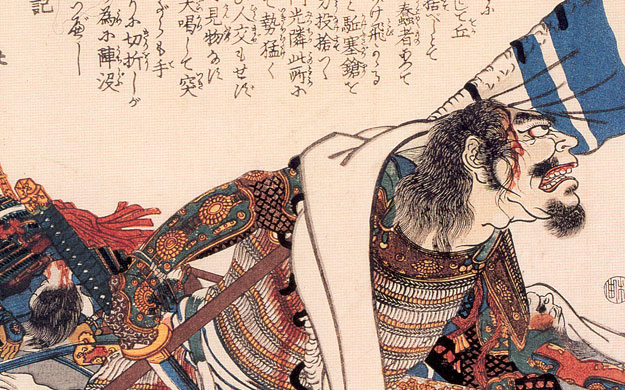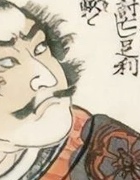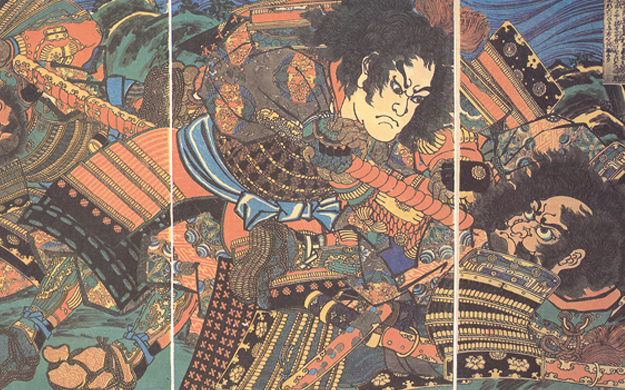
A number of aikido teachers do not only teach aikido, but also a sword fighting style from the 15th century: the Tenshin Shoden Katori Shinto ryu. Interestingly however, there seems to be no integration of the two styles. What sword practice there is in aikido is either the aikiken system, which apparently was mainly developed by Saito Sensei and hardly has anything to do with the traditional samurai sword styles, or some basic elements from the Kashima Shinto ryu that Ueshiba seems to have copied by sending some pupils on a scouting mission. Similarly, Katori Shinto ryu has its own system of yawara or ju-jutsu, though it is not often practised.
The question I (as a grade holder in both aikikai aikido and Shinto ryu) was once asked, was therefore not easy to answer: What is the relationship between aikido and Katori Shinto ryu?
Strictly speaking there is none: the styles do not overlap, and where one ventures out into the territory of the other (e.g., aikido teachers instructing in the use of sword or stick) I’m inclined to say: cobbler, stick to your last. Nevertheless, it is possible to draw some connections, which may deepen our understanding of both styles.
I see three kinds of connections: in historical personal relations, in the development of both styles within the greater corpus of the Japanese martial arts, and in the physical and spiritual doctrines as they exist in both styles today.
1.
Without personal relations there would be no Katori Shinto ryu in the Netherlands and this article would not exist: it used to be very hard to join a Japanese koryu – a school that was founded before 1868. A personal introduction was required; spies and other riff-raff had to be kept out. Thus the relations between the dojo of Yoshio Sugino Sensei in Kawasaki (where Katori Shinto ryu was taught) and the Aikikai Hombu Dojo made it possible for foreign students – a rare species at the time – to join the Katori Shinto ryu. Yoseikan aikido students came to Sugino in a similar way: their teacher Mochizuki and Sugino had both been students of Kano (the founder of judo) in the twenties and of Ueshiba in the thirties, and after 1945 the Sugino dojo was one of the first dojos outside of the Hombu Dojo where aikido was taught. These days it is very easy for anyone in the Netherlands practicing aikido, aikibudo or even no martial art at all to take Katori Shinto ryu lessons.
I could develop a thesis that strenghtens these historical ties, as it is said that both Takeda Shingen, the famous samurai warlord of the sixteenth century, and Yamamoto Kansuke, one of his most important strategists, were members of the Katori Shinto ryu – and Takeda’s descendants developed the Daito ryu aikijujutsu, that brought forth our aikido. But this thesis would require some more evidence.
2.
Whether that last statement is true or not, it is easy to see that aikijujutsu and aikido stem from older forms of jujutsu, which were practised by the samurai – warriors that never went unarmed, even carrying a short sword or dagger in the house, and fought in armour or hakama. Hence the emphasis on techniques in which the hand or arm is attacked (to prevent the drawing of weapons), in which locks are more important than punches (locks are more efficient against an armoured opponent) and in which there seem to be no kicks (try a high maegeri when you’re wearing 60 pounds of armour or even just a hakama). Daito ryu aikijujutsu (called simply “ju-jutsu” before 1922) was only one of the myriad of yawara or ju-jutsu styles, just as Katori Shinto ryu was one of the many koryu: schools in which sword, naginata (halberd), yari (spear) and all other weapon techniques were considered to be the most important, with some ju-jutsu thrown in just in case. A warrior could not afford not to be familiar with certain aspects of martial arts, which explains the parallels in the principles behind the different forms. I will address these further in paragraph 3.
There is an important difference between aikido and Katori Shinto ryu that could only appear in the twentieth century. Aikido, or rather aikikai, positions itself as intended for peace, harmony with the universe, universal love and respect. Ueshiba strongly stressed the difference with the old forms of budo, which taught to kill if necessary. Ueshiba claimed to have stripped the old techniques of their deadly aspect: aikido techniques neutralise danger and show the futility of using violence, but do not inflict permanent damage.
Although at first sight this seems to be an important theoretical difference with the koryu, I do not think it holds up under closer inspection. Firstly, I do not believe Ueshiba succeeded in his goal. If we look at aikido as an art of self defense, devastating atemi, always aimed at vital points, seem to be essential in disturbing the opponent’s balance and creating the opportunity to execute a technique. But even if they were not, I can’t see how someone who does not know about ukemi and how to break his fall could survive a serious irimi nage without breaking his neck or cracking his head. Modern aikido frequently assumes that the aggressor knows aikido as well, and moreover takes the sort of ukemi that is necessary to execute the technique in a particular substyle. Secondly it is not completely true that the koryu did not desire peace. Does the character for war not really mean “restraining the spears”? The Chinese strategists knew, better than Bush or Bin Laden, that the best general wins without a fight. The Katori Shinto ryu teaches that heiho, the art of war, is also heiho, the art of peace (“hei” is written with a different character). While this can to a degree be attributed to Buddhist influences, it strikes me that predators, too, will only fight each other if there is no other way, and will first try to scare off the opponent by puffing up, growling, etc. Real fights lead to injuries, and injuries make it difficult to hunt. In short, it has always been the nature of the art of war to think about peace.
3.
Finally let’s have a look at the similarities and differences in the physical and spiritual doctrines of aikido and Shinto ryu today. I do not want to make a distinction between these two aspects. The cartesian dualism stands in complete contrast to the theory and practice of budo, in which mind and body are one. The vital life energy (the ki) is both mind and body, runs through both, and can be blocked in both. This is already visible in the basic exercises of both aikido and Shinto ryu: positions that at first seem to be purely physical, but after some practice turn out to be deeply connected to the shin or kokoro, the mindset.
In general it is my experience that in aikido, as it is taught in the aikikai, there is from the start an emphasis on a relaxed posture and fluent movements, whereas in the Shinto ryu the emphasis from the start it is much more on the exactness of posture and movement (in both cases this of course depends on the specific teachers as well). In the end the goal is the same (exact and fluent movements), but in the Shinto ryu the student is much more held “in check”. Which is only natural, of course: he is after all trying to hit someone with a heavy wooden practice weapon.
The basic position in aikido, hanmi (“half body”) is the same as the seigan-no-kamae, the basic position in Sugino-style sword fighting (not in the Otake-style, where the hips are not turned away). Clearly hanmi is a sword position, though strikingly some aikido instructors teach it as turning the torso more towards the partner – a mortal sin for a sword fighter, because he needs to keep as much from his body as is possible out of reach from the opponent’s weapon. As Baron de Bazancourt once wrote in his Secrets of the sword in the 19th century: “A sharp point is a peremptory fact, which makes quick work of illusions”. Another notable difference is that in the Shinto ryu someone who is standing in seigan, and therefore in optimal guard, will never, at any point in the kata, be attacked. You are only attacked if you leave an opening. In aikido, on the other hand, uke is expected to attack someone precisely as they are standing in hanmi. In my opinion this is a loss of realism.
Taisabaki, body movement, first taking the body out of the line of attack and then executing the own technique, is the doctrine of both schools. Hyoshin, the right timing; ma ai, the right, dynamic (and hence changing) distance; zanshin, “simple awareness”, awareness of the situation without preconceptions, fears or desires; metsuke, the right way to look, “seeing the faraway as close by and the close as far away” as Musashi put it; these elements are essential and principally the same in both aikido and Shinto ryu.
My conclusion is that upon closer inspection aikido and Shinto ryu are more similar than one would have thought. But they are their own disciplines and can only be practised for their own worth. Not everyone thinks, deep down, that it is great to (have to) be thrown in all directions, and not everyone’s heart jumps with joy when they pick up a sword.
Stephen Snelders
